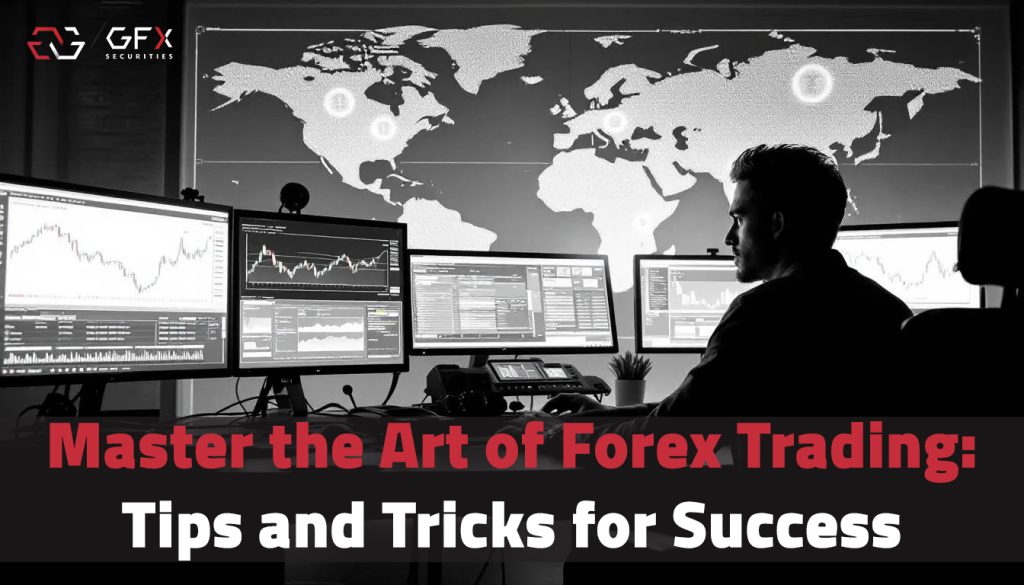
How to Master Forex Trading in 2025:
Powered by GFX Securities
Introduction
In the dynamic world of foreign exchange, mastering forex trading requires more than luck—it demands discipline, strategy, and continual adaptation. As daily forex volumes surge past $9 trillion, the competition is fierce and the margin for error is slim.
At GFX Securities, we’ve observed that success in 2025 is increasingly defined by traders who combine smart forex trading strategies, rigorous risk management, and psychological resilience.
In this guide, we’ll walk through top-tier tactics—spanning trend identification, algorithmic tools, news-driven setups, and emotional control—so you can trade smarter and more consistently.
Part 1: Foundation – Building Your Forex Strategy
1. Choose Your Style & Timeframe
Whether you’re a day trader, swing trader, or longer-term position holder, your style should align with your personality, time commitment, and risk tolerance. Experts list the most popular strategies for 2025: algorithmic trading, trend-following, news-based trades, and carry trades.
- Day trading / scalping: Quick entries and exits, suited for liquid major pairs.
- Swing trading: Hold for days or weeks; capitalise on medium-term momentum.
- Position trading: Longer-term holds; benefits from macro trends.
Choose your primary style, then refine with complementary tactics.
2. Build a Trading Plan
A reliable trading plan is the backbone of any successful trader. Your plan should contain:
- Entry and exit rules
- Position sizing and risk per trade
- Preferred trading pairs
- Criteria for holding vs closing
Resources emphasise that the lack of a solid plan is one of the fastest ways to underperform.
At GFX Securities, our platform allows you to implement, test, and refine your plan using demo accounts before going live.
3. Leverage Risk Management
Risk management isn’t optional—it’s essential. Some key elements:
- Set maximum risk per trade (e.g., 1–2% of account)
- Use stop-losses and adjust lot sizes accordingly
- Monitor your cumulative trade exposure
Historically, successful traders emphasise that protecting your capital is more important than chasing big winners.
Part 2: Advanced Tools & Trends Shaping 2025
4. Trend-Following & Breakout Techniques
Trend-following remains one of the most effective strategies in forex markets. Research shows it works well for high-liquidity currency pairs.
- Day trading / scalping: Quick entries and exits, suited for liquid major pairs.
- Swing trading: Hold for days or weeks; capitalise on medium-term momentum.
- Position trading: Longer-term holds; benefits from macro trends.
Choose your primary style, then refine with complementary tactics.
Key signals:
- Moving Average Crossovers
- Breakouts above resistance / below support
- Confirm with ADX (Average Directional Index) for trend strength
Breakout trades require good entry discipline and selective risk.
5. News-Driven & Sentiment-Based Trading
In 2025, major currency moves are still sparked by macro releases, policy announcements and geopolitical events.
Traders use:
- Economic calendar for high-impact events
- Sentiment tools monitoring central bank speeches, social media, trade headlines
At GFX Securities, news feeds and sentiment overlays help you react more quickly and rationally
6. Algorithmic & Automated Strategies
As algorithmic trading and machine learning flood the FX space, traders who combine automated rules with discretion gain an edge.
Highlights:
- Create rulesets that execute automatically based on indicators/news
- Use backtesting to validate performance
- Remain aware of model risk, regime changes and overfitting
Part 3: Psychology & Behaviour
7. Emotional Discipline & Psychological Edge
Your mindset matters. Many traders lose because of:
- Impulsivity
- Fear of missing out
- Revenge trades after losses
Success comes from sticking to your plan, avoiding over-trading and managing stress. Incorporate mindfulness, journaling and regular reviews into your routine.
8. Continuous Learning & Adaptation
Forex markets evolve—what worked in 2010-2020 may not work the same in 2025. Top traders commit to:
- Regular review of trade performance
- Refining strategies based on current liquidity, volatility and policy themes
- Staying updated on tools, algorithms and trading psychology
Part 4: Tying It Together – Your Actionable Checklist
Here’s a step-by-step checklist to implement what you’ve learned:
- Define your trading style and timeframe
- Write down your trading plan + risk rules
- Choose 1–2 strategies from trend, news and algorithmic approaches
- Backtest those strategies using GFX Securities demo environment
- Monitor trades and avoid emotional entries — use alerts to stay disciplined
- Review your results monthly and refine based on what’s working
- Stay updated on macro outlooks, tools and market psychology
Conclusion
1. Choose Your Style & Timeframe
Mastering forex trading in 2025 isn’t about a single “holy-grail” indicator—it’s about blending strategy, discipline and adaptation. At GFX Securities, we believe real success comes from:
- A clear trading style
- A robust plan + risk system
- Use of advanced tools (trend following, sentiment analysis, algorithmic automation)
- Solid psychological control and continuous improvement
By following this framework, you’ll be better positioned to navigate volatile markets, capture opportunities and build sustainable trading performance.


